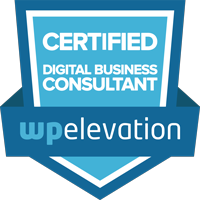How to Monitor the SEO Metrics That Actually Matter
SEO is not something you set up once and forget. It requires ongoing monitoring to ensure your website remains visible, competitive, and capable of attracting the right audience. It involves tracking KPIs that show whether your strategies are working or if adjustments are needed. It includes keeping an eye on rankings, organic traffic, backlinks, and technical factors that influence search performance.
As long as you regularly monitor your SEO efforts you can identify areas ripe for exploitation and prevent competitors from gaining an edge on your service or product. However, most businesses don’t need to do literally everything the SEO playbook tells you to do. Not two businesses are the same and the idea of ranking number one for every keyword is ridiculous. Competition is too fierce for that.
But it is worth understanding what you, as a marketing director or business owner can do to attract the right types of clients. In this blog, we’ll explain what to track, which tools to use, and how to monitor SEO effectively so your website stays optimized for long-term success, hitting the targets that you most care about.
How do you monitor SEO effectively?

Well, firstly, SEO changes constantly. Search engines frequently update their algorithms, which affects how websites rank. What worked six months ago might not work today. User behavior also shifts over time, meaning search intent, trends, and competition evolve. Without active monitoring, you could fall behind without realizing it.
What happens if you neglect SEO monitoring?
It’s understandable, for many businesses, big and small to let SEO slip by the wayside. But you know that sinking feeling you get when you don’t see your page rank well for your desired keywords? Yeah, that is a symptom of letting SEO slide. Here are some other negative outcomes of leaving SEO in the too-hard basket.
- Traffic declines—without tracking, you may not notice a gradual drop in visitors until it significantly impacts your business.
- Technical SEO issues—slow load times, broken links, or indexing errors can hurt visibility.
- Lower conversions—if traffic quality decreases, leads and sales will suffer.
Why regular SEO monitoring matters
Imagine launching a new online store. You spend months crafting product descriptions, optimizing your pages, and building backlinks. At first, you see a steady increase in traffic, but then, without warning, visits start declining. What changed? Was it an algorithm update? Is a competitor outranking you? Is a technical issue slowing down your site? Without regular monitoring, it’s hard to know. Even worse it becomes quite laborious trying to fix it!
Consistent SEO tracking ensures you can:
- Stay ahead of competitors by spotting ranking shifts and refining your strategy accordingly.
- Identify emerging trends so you can update content or target new keywords before your competitors do.
- Ensure your site remains optimized for both search engines and users by catching issues like slow load times, broken links, or outdated metadata.
- Maximize your ROI by focusing on what’s working and eliminating wasted efforts.
What are the key metrics to monitor for SEO success?

Ok, so the good news is you don’t need to do everything. You have a business to run, right? However, by starting with the low-hanging fruit, you can arrest the decline in your rankings, and create a platform which you can build on or hand off to an SEO pro who knows how to take things to the next level!
Traffic metrics
Tracking organic traffic trends helps determine whether SEO efforts are driving results. Key insights include:
- How many visitors arrive from search engine results pages (SERPs)
- What keywords are bringing that search traffic
- What keywords the site already ranks for
- What pages specifically are bringing the most search traffic
Keyword rankings
Knowing where your website ranks for target keywords is crucial. If rankings drop, it could indicate algorithm changes, increased competition, or outdated content. Tracking position changes over time helps guide SEO strategy adjustments.
With a tool like SEMrush, you can also find keyword gaps giving you an edge over competitors when searchers indicate they are after a certain answer to their query.
Domain authority
Domain Authority is a score that predicts how well a website is likely to rank. A higher DA generally means stronger credibility and better search visibility. DA is influenced by:
- Backlink quality: Getting links from reputable sources improves your score.
- Content strength: High-value, informative content boosts credibility.
- Technical SEO health: A well-structured website with clean code and fast loading times improves authority.
Backlink profile
Backlinks play a critical role in SEO. Monitoring both the quantity and quality of backlinks ensures your site benefits from a strong external link network. Having a backlink strategy in place can be time-consuming though and requires a lot of patience. By creating great content you are in a better place to entice other reputable sites to site your content as authoritative. In many companies, a dedicated backlink professional is charged with executing this strategy, giving you an idea of how tricky it can be to gain traction.
On-Page SEO factors
Search engines prioritize websites that offer a fast, user-friendly experience. The following elements are non-exhaustive but are a good start to get your content sending positive signals to crawlers.
- Page load speed: slow pages lead to higher bounce rates and lower rankings.
- Mobile-friendliness: Google prioritizes mobile-friendly sites, so your website should be fully optimized for mobile users.
- Metadata optimization: Title tags and meta descriptions should be clear, relevant, and keyword-focused to improve click-through rates.
Competitor analysis
Oh yes. Are you aware that your competitors are likely doing the same to you? This game of cat and mouse exists in many industries. Understanding searcher intent is only half the battle. Knowing how your competitors are using longtail keywords to gain exposure and either replicating or augmenting their strategy is a really good plan.
Before attempting competitor analysis have a strategy that understands:
- What keywords your competitors are ranking for that you aren’t.
- Where they are getting their backlinks from.
- What parts of their content strategy compares favorably to yours.
5 great tools for SEO monitoring

Different tools provide unique insights into various aspects of SEO. Here are five of the most effective tools SEO specialists use and what they bring to the table.
1. Moz
Moz is a well-rounded SEO tool designed to help businesses track their website’s authority, keyword rankings, and backlink profiles. One of its standout features is Domain Authority, a proprietary score that predicts how well a website is likely to rank on search engines. By monitoring DA over time, businesses can gauge their site’s credibility and understand how their SEO efforts impact overall authority.
2. Ahrefs
Ahrefs is a powerful SEO tool best known for its in-depth backlink analysis, keyword research, and competitor monitoring. Its extensive link database makes it one of the most reliable platforms for assessing a website’s backlink profile. Businesses can use Ahrefs to identify high-quality links, detect harmful backlinks, and discover new link-building opportunities to strengthen their site’s authority.
3. SEMRush
For those new to SEO, SEMRush can feel overwhelming at first. The sheer number of features, along with its price tag, might seem excessive compared to other options on the market. However, if you’re committed to serious SEO growth, SEMRush is the Death Star of SEO tools, capable of uncovering opportunities that other platforms miss.
4. Google Search Console
Unlike broader SEO tools that analyze multiple sites and competitors, Google Search Console focuses solely on your website, making it the first port of call when diagnosing search-related problems.
One of its most critical functions is indexation tracking. GSC helps you understand which pages of your website are being indexed by Google and which aren’t. If a page isn’t showing up in search results, GSC allows you to submit it for indexing or diagnose issues like crawl errors, robots.txt restrictions, or canonical tag conflicts.
5. Google Analytics
When optimizing a website, you often start by using SEO tools to analyze rankings, keyword performance, and competitor data. Once you identify potential issues you can turn to Google Analytics to investigate further. Are users bouncing more frequently? Are they leaving from a specific page? Is organic traffic down across the board or only in certain areas? Google Analytics provides the context behind ranking shifts, helping you connect cause and effect.
The process also works in reverse. Sometimes, the first sign of trouble appears in Google Analytics. You might see a sharp drop in organic sessions, declining engagement, or a sudden increase in exit rates. Instead of guessing why, you can use an SEO tool to dig deeper into rankings, backlinks, and technical performance to identify the root cause and reverse a downward trend before it gets worse.
Common SEO monitoring errors

At Tiny Blue Sky, we have seen it all when it comes to how clients attempt SEO monitoring, but the most common mistakes are as follows:
Overlooking UX metrics
Many businesses focus their SEO efforts on content and keywords but neglect technical factors like mobile performance, page speed, and structured data. With Google’s mobile-first indexing, search engines primarily evaluate the mobile version of your site when determining rankings. A slow, poorly optimized mobile experience can significantly hurt your visibility, even if your desktop site is well-structured.
Ignoring local SEO
For businesses with a physical presence, local SEO is essential for appearing in Google’s local pack, Google Maps, and location-based searches. Yet, many businesses overlook this, focusing only on general keyword rankings instead of optimizing for local visibility.
To correct this claim and optimize your Google Business Profile, ensure your contact details, hours, and services are accurate. Always respond to customer reviews because businesses with strong, positive reviews tend to rank higher in local search results. Finally, and perhaps most importantly, use local keywords naturally in your content, such as city and neighborhood names relevant to your business.
Letting toxic links pile up
Backlinks, while challenging to get, are one of the strongest ranking signals in SEO, but not all links are going to give you the boost you need. Many businesses focus on acquiring new backlinks but fail to monitor their existing link profile, allowing toxic or spammy links to accumulate over time.
Focusing only on rankings
Rankings are just one piece of the puzzle. What matters is what happens after someone lands on your site.
Instead of obsessing over positions in search results, dig into Google Analytics to see whether visitors are engaging with your content. Are they staying long enough to read? Are they clicking through to other pages? Are they taking action? Metrics like time on page, pages per session, and conversion rates tell a far more valuable story than rankings alone.
How Tiny Blue Sky simplifies SEO monitoring

SEO is one of those things every business owner knows is important, but finding the time to do it right is another story. You are focused on growth, working with clients, and keeping everything running. Digging into rankings, backlinks, and site performance often gets pushed to the bottom of the list. We get it. Sometimes the smartest move is to bring in experts who can cut through the noise and find what really matters.
With over 20 years of experience, our team takes a holistic approach to SEO. We look for the spaces that actually move the needle. The overlooked opportunities, the technical fixes that make a difference, and the strategies that help you attract the right clients, not just more traffic. If you are tired of the trial-and-error approach, let’s talk.






